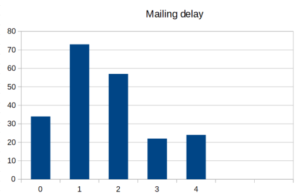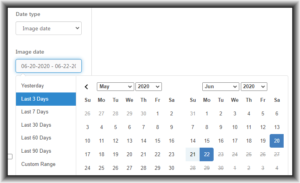
(This is Patentcenter trouble ticket CP31.)
The designers of Patentcenter got it seriously wrong when they picked the default setting for the display of “Outgoing Correspondence”. The result for practitioners who until now have been accustomed to the default setting in EFS-Web is that the “Outgoing Correspondence” feature of Patentcenter is a trap for the unwary.
If you’re like me, part of your daily routine is to go to Private PAIR each day and click on “View Outgoing Correspondence”. You then scan down through the listings on the page to see what needs to be reported to clients, what needs to be reported to foreign instructing counsel, and what needs to be docketed.
USPTO is beta testing Patentcenter as its successor to Private PAIR. At some point USPTO will shut down Private PAIR and if you want to do anything that you formerly did by means of Private PAIR you will need to do it by means of Patentcenter.
So of course if you want to be smart about all of this, you will start using Patentcenter now so that if there is anything wrong about it, you can report it to the USPTO and USPTO can fix it now before it’s too late to fix it (after things about it get carved into stone). (And of course you will join the Patentcenter listserv so that you can contribute to the trouble ticket system and be part of the beta testing community.)
Anyway, back to “View Outgoing Correspondence”.
I went into Patentcenter this morning and clicked in the place where you click in Patentcenter to view outgoing correspondence. (In Patentcenter, the way you do this is to click on “Workbench” and then “View Correspondence”). And on my screen for today, there was just one lone piece of correspondence on the screen.
As Three Dog Night sang in 1969, one is a lonely number. It seemed a bit odd that there would only be one piece of outgoing correspondence given the number of active files on my firm’s docket at the present time. It seemed particularly odd given that we are approaching the end of a calendar quarter and Examiners at the USPTO are of course anxiously trying to collect “counts”.
Now if you have ever sat through one of the training sessions for alpha testing of Patentcenter (as I did several times as long ago as autumn of 2018) or one of the the training sessions for beta testing of Patentcenter (as I have done by now many times), one of the things you have heard is that the designers of Patentcenter intend that Patentcenter will do everything that PAIR and EFS-Web do, but better. If the presenters in the training sessions got it right in their description of the development process, one of the jobs of the designers of Patentcenter was to go through the feature lists and user interface descriptions of PAIR and EFS-Web and replicate those functions item by item in the user interface of Patentcenter. Well that, and of course make it faster, more user-friendly, more reliable, and just generally better in every way. That is what the presenters in the training sessions have told the attendees, over and over again.
So what this should mean is that if I were to go to the trouble right now this morning of logging in at Private PAIR to “View Outgoing Correspondence” it should be the exact same Three Dog Night situation. One lonely piece of outgoing correspondence that requires my attention.
Well would you look at that! In Private PAIR, my “View Outgoing Correspondence” screen lists thirty-one items. Most importantly, it lists nine items of outgoing correspondence with a mailing date of today, June 23, 2020.
How can it possibly be that when I do the two mouse clicks in Private PAIR to view today’s outgoing correspondence, I see nine items, and yet when I do the two mouse clicks in Patentcenter to view today’s outgoing correspondence, I see only one item?
Or to put this as plainly as possible, the missing eight items are a trap for the unwary. A malpractice lawsuit waiting to happen if somehow I end up failing to docket one or more of those eight other items of correspondence. Why? Because stupidly I trusted that those USPTO people actually accomplished what they said they were trying to accomplish when they were designing Patentcenter to replicate and improve upon the functions of PAIR.
It took a little while but eventually I figured out the design mistake that the Patentcenter designers made. It is tied to the average slowness of the USPTO clerks who “image” documents and then “mail” the documents.

I looked through the past 180 days of outgoing correspondence which the USPTO mailed to my firm, and calculated how many days it took the clerks to actually “mail” each piece of correspondence that a clerk had “imaged”. The modal value for the delay was “one”, that is, it took one day more often than it took any other number of days, for the USPTO clerk to get around to mailing a piece of correspondence that the clerk had imaged. This was 73 pieces of correspondence out of a total of 210 pieces of correspondence, or 35% of the correspondence. Said differently, about one-third of the time the USPTO clerk mailed out the correspondence one day after imaging it.
Here are the exact numbers and percentages:
| days of delay | occurrences | percent |
| 0 | 34 | 16% |
| 1 | 73 | 35% |
| 2 | 57 | 27% |
| 3 | 22 | 10% |
| 4 | 24 | 11% |
The key here is that the highest observed number of days of delay is “four”.
In Private PAIR, the default setting is that what you will see on your screen is the outgoing correspondence that was mailed today and was imaged within the past seven days. And … wait for it … four is a smaller number than seven. This means that in Private PAIR you will always see all of today’s outgoing correspondence if you click on “View Outgoing Correspondence”.

But the designers of Patentcenter screwed up. They configured the default setting so that what you will see on your screen is the outgoing correspondence that was mailed today and was imaged no more than three days ago. And … wait for it … four is a bigger number than three. This means that in Patentcenter you will miss an average of eleven percent of your outgoing correspondence. Today, the USPTO clerks got around to mailing eight pieces of correspondence that they imaged four days ago. So those eight pieces of correspondence did not show up on my Patentcenter outgoing correspondence screen.
So what did I do wrong as a user? Is it that I failed to check diligently every day? No, that’s not it. I did click in Patentcenter yesterday to look at my outgoing correspondence. But as of yesterday, those eight pieces had not been mailed yet. Yes, they had supposedly been “imaged” but that is an internal function within the USPTO, not visible to anyone outside of the USPTO. I could not see them yet because they had not yet gotten “mailed”.
Yes, the design mistake was for the USPTO people to pick “three” as the number of days that Patentcenter would go back when it looked for imaging dates of documents to report to the user for outgoing correspondence. “Three” is wrong. The correct number absolutely must be four or greater, given that the actual observed behavior of the USPTO clerks is that eleven percent of the time, they sit on imaged documents for four days before mailing them.
The designers of PAIR got it right because they picked “seven” and seven is bigger than four. The designers of Patentcenter got it wrong because they picked “three” and three is smaller than four.
What might be baffling here is that yes of course the responsible thing to do when designing this screen would be to do what I did. Go and look and see what the actual behavior is of the USPTO clerks. It is easy enough to analyze six months’ worth of data (as I did) and to find that quite often, the clerks sit on documents for four days. It is easy enough to work out that the default number in this “outgoing correspondence” screen absolutely must be a number at least as big as “four”.
But that’s not the baffling part. The baffling part is, given that the designers of PAIR had picked “seven”, how did the designers of Patentcenter get it into their heads that they should do anything other than replicate this function of PAIR? How did they get it into their heads that in Patentcenter, they should change from the number “seven” to some other number?
The default setting for this screen in Patentcenter needs to get set to at least “four”. This is Patentcenter trouble ticket CP31.

And unfortunately, there appears to be no function in Patent Center to set your preferences for settings ilke that. So every time you have to remember you need to set the number to seven.